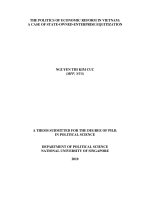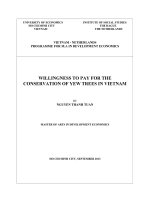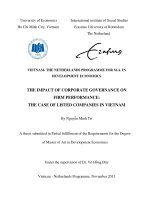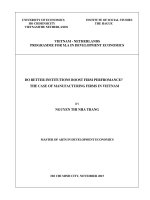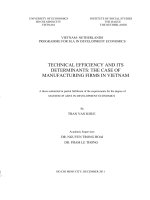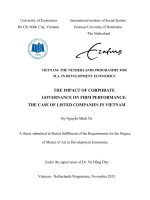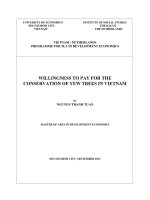Essay: The status of current account in Vietnam before and during Covid19 pandemic
Bạn đang xem bản rút gọn của tài liệu. Xem và tải ngay bản đầy đủ của tài liệu tại đây (115.83 KB, 6 trang )
International Finance Assignment
1. Introduction
In the present time, globalization is developing rapidly in each country, no tariffs, no
economic obstacles. As a result, GDP growth rate is continuously increasing and
paving the way for the fourth industrial revolution. However, recent macroeconomic
crises in developing countries have once again underscored the need for a clear
understanding of the factors underlying a country's current account position. So what
is current account and its important influence on developing countries?
On the one hand, the current account records a nation's transactions with the rest of
the world - specifically its net trade in goods and services, its net earnings on crossborder investments, and its net transfer payments - over a defined period of time,
such as a year or a quarter.
In addition, current accounts include 3 main factors: Balance of Trade, Primary
Income and Secondary Income. In which, Balance of Trade includes import and
export activities of goods and services. Primary Income includes Salary of Labor and
Income from Investment (FDI1, FPI 2and Credit). And finally Secondary Transfer with
money transfer operations.
The current account may be positive (a surplus) or negative (a deficit); positive
means the country is a net exporter and negative means it is a net importer of goods
and services. In either case the country's capital account balance will register an
equal and opposite amount. Exports are recorded as credits in the balance of
payments, and vice versa imports are recorded as debits.
On the other hand, as we know that the balance of trade (exports minus imports) is
generally the biggest determinant of the current account surplus or deficit, the
current account balance often displays a cyclical trend. Especially, during a strong
economic expansion, developing countries often have stronger import volumes than
exports. However, if exports are unable to grow at the same rate, the current account
deficit will widen. Conversely, during a recession, the current account deficit will
shrink if imports decline and exports increase to stronger economies.
Besides, the exchange rate exerts a significant influence on the trade balance, and
by extension, on the current account. An overvalued currency makes imports
cheaper and exports less competitive, thereby widening the current account deficit or
narrowing the surplus. An undervalued currency, on the other hand, boosts exports
and makes imports more expensive, thus increasing the current account surplus or
narrowing the deficit.
2. The problem of current account deficits in developing countries
2.1. The cause of current account deficits in developing countries
There are various factors which could cause a current account deficit:
1 FDI: Foreign Direct Investment
2 FPI: Foreign Portfolio Investment
Overvalued exchange rate.
Economic growth.
Decline in competitiveness/export sector.
Higher inflation.
Recession in other countries.
Borrowing money.
Financial flows to finance current account deficit.
2.1.1. Overvalued exchange rate.
When a developing country overvalues its currency, imports will be cheaper, and
therefore there will be a higher quantity of imports. Exports will become
uncompetitive, and therefore there will be a fall in the quantity of exports. As a result
its current account would be deficit.
2.1.2. Economic growth.
When there is an increase in economic growth, national income also enhanced,
people have more disposable income to consume goods. Therefore, people have
more demand for foreign goods, partly because the quality of domestic goods is not
as good asthan imported ones. This is because developing countries are still unable
to produce high quality goods to meet the needs of their people.
2.1.3. Decline in competitiveness/export sector.
Similar to the above reason, it is also because the production capacity of developing
countries is still weak, so their comparative advantage is low. So they still have to
import a lot from foreign countries such as raw materials, machinery or even highly
skilled labor.
2.1.4. Higher inflation.
If their inflation rises faster than our main competitors then it will make their exports
less competitive and imports more competitive. This will lead to deterioration in the
current account. However, inflation may also lead to a depreciation in the currency to
offset this decline in competitiveness.
2.1.5. Recession in other countries.
In addition to factors originating in developing countries themselves, relationships
with other countries also affect current accounts, for example, if the US experience
negative economic growth, they will buy less goods from Vietnam, this worses the
Vietnam current account.
2.1.6. Borrowing money (Credit)
If countries are borrowing money to invest, and the investment is less profitable than
the interest on the debt (or the cash inflow is less than the cash outflow) then this will
lead to deterioration in current account position.
2.1.7. Financial flows to finance current account deficit.
If a country uses foreign debt to finance investments that yield more than the interest
rate on debt, it can maintain solvency while still having a current account deficit.
However, if a country is unable to pay its current debt with future revenue flows, that
country could lose its solvency (or insolvency).
2.2. Solutions to deal with current account deficits in developing countries
To reduce current account deficits, developing countries need to implement the
following policies:
2.2.1. Devaluation of exchange rate and Deflationary policies
On the one hand, they should devaluate exchange rate to make exports cheaper and
imports more expensive. This involves reducing the value of the currency against
others. (e.g. selling VND would cause the value of the VND to fall).
If there is a devaluation of the currency, the price of imported goods increases and
therefore the quantity demanded of imports falls. Exports will become cheaper, and
there will be an increase in the quantity of exports.
But first, I am going to explain by J curve effect.
Table 1. J curve effect
The J curve effect shows that the balance of payments trend is in deficit at first,
then turns into surplus when a step devalues its currency.
As soon as a country's currency depreciates, imports become more expensive and
cheaper exports make the trade deficit worse (or at least a smaller trade surplus).
Soon, the country's export sales volume began to increase steadily, because of
relatively cheap prices.
At the same time, consumers in that country start to buy more domestically produced
goods because they are relatively affordable in comparison to imported goods. Over
time, the trade balance between that country and the partner country is restored,
even exceeding the previous devaluation period.
This is precisely because the devaluation of the national currency had an immediate
negative impact because of the inevitable delay in meeting the growing demand for
the country's products.
On the other hand, they also could use deflationary policies, these are policies
aiming at reducing the growth of aggregate demand and reducing inflation. They can
include a tightening of fiscal policy or monetary policy; this will reduce aggregate
demand.
2.2.2. Monetary policy
Firstly, they could tighten monetary policy, this involves increasing interest rates.
Higher interest rates will increase the cost of debt and mortgage repayments and
leave people with less money to spend. Therefore, this will reduce their consumption
of imports, improving the current account.
Also, higher interest rates will cause a fall in aggregate demand and therefore
reduce economic growth. This will reduce inflation and help to make exports more
competitive.
And lastly, deflationary policies will also put pressure on manufacturers to reduce
costs, and this will lead to more competitive exports, and so exports may increase in
the long run because of this effect.
However, in addition to monetary policy, the government can influence through fiscal
policy. For example, the government could increase income tax. This would reduce
consumer discretionary income and reduce spending on imports. But this policy will
conflict with other macroeconomic objectives - with lower aggregate demand (AD),
growth is likely to fall causing higher unemployment. And absolutely this is too risky
to trade off.
2.2.3. Supply side policies & Protectionism
Supply side policies can improve the competitiveness of the economy and help make
exports more attractive. This can improve the current account position, but it may
take considerable time to have an effect.
For example, if the government pursued a policy of privatisation and deregulation it
may help to increase the efficiency of the economy because of the profit motive in
the private sector. This increased efficiency would translate into lower costs of
production and more exports.
By contrast, the government could increased tariffs on imports or even impose
quotas. Both these measures would have the impact of reducing imports and
therefore improve the current account.
2.3. The status of current account in Vietnam from 2015 to 2020
T he status of current account in Vietnam
from Q1/2015 up to Q3/2020
(in million USD)
10000
8368
8000
6261
6000
4300
4000
3499
691 479
0
-2000 -1341
3139
3018
2632
2242
2000
4840
4300
3934
1677
1244
1077
270
155
-616
-1169
-300
-323
Current Account
Table 2. Current account of Vietnam from Q1/2015 to Q3/2020
According to the table 2, from the first quarter of 2015 to the third quarter of 2020,
Vietnam's current account fluctuated slightly, but it was generally an increasing trend
over time.
Starting from a deficit of $ 1341 million in early 2015, the current account gradually
increased again until the end of 2016, at approximately $ 3499 million in surplus.
However, due to the economic upheavals in the world, Vietnam's balance fell sharply
in early 2017, even having a deficit of $ 1169 million in the middle of the year. This is
explained by the cuts in labor from industries and an increase in the consumer price
index that makes domestic goods more expensive, leading to a loss of competitive
advantage in international markets.
Then, the current account remained relatively stable in the next four quarters at over
$ 3,000 million. However, in the last 2 quarters of 2018 and the first 2 quarters of
2019, it declined significantly, ending with a deficit of about 300 million USD in the
second quarter of 2019. After a long deficit, Vietnam boosting exports by the end of
2019, recording at $ 6261, $ 4840 and $ 3139 million in the next three quarters,
respectively.
And finally, due to the impact of the Covid-19 pandemic, in the second quarter of
2020, Vietnam had to import from foreign countries because domestic production
had not recovered promptly after the negative effects of the epidemic, for instance,
the current account deficit is more than 300 million dollars. However, after that, a
positive signal appeared when in the third quarter of the same year, Vietnam's
current account reached more than 8,000 million USD, showing a strong recovery of
economic activity of Vietnam, overcoming difficulties and obstacles caused by the
Covid-19 pandemic.
3. Conclusion
In conclusion, the current account reflects the proportion of exports and imports in
each country's balance of trade, and as I said above, developing countries are facing
current account deficits. There are many reasons for this situation, and countries
need to come up with appropriate policies to stabilize the economy.
While the current deficit may imply that a country is spending beyond its budget, a
current account deficit is not a disadvantage. In fact, if a country can attract more
financial flows (either short-term portfolio investment or long-term direct investment),
then these flows on the financial account will enable the country to run a larger
current account deficit.
Additionally, by having a good foundation and if the Covid-19 pandemic is under
control in Vietnam as well as in the world, Vietnam's economy will recover by 2021.
Covid-19 also shows a need for strong reforms. In order to help recover the
economy in the medium term, such as improving the business environment,
promoting the digital economy, and improving the efficiency of public investment,
these are the main issues that Vietnam needs to consider for rapid reform and
stronger.
References
1. International Financial Management, 12th Edition - Jeff Madura
2. Investopedia: />
